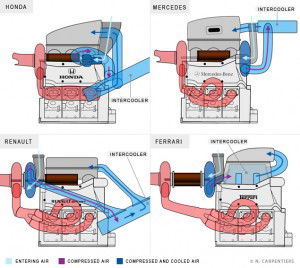

The year 2016 marks the third year we find ourselves in this revamped Turbo era of Formula One. Teams now have stacks of data that puts even Vatican archives to shame. So with this much knowledge and lessons that have been learnt over two years, engineers at Maranello & Ferrari have (supposedly) come up with a new engine design, albeit the same 1.6L Turbo Charged V6 with hybrid electronic systems on board called the MGU-H (Motor Generator Unit – Heat ) and the MGU-K (Motor Generator Unit – Kinetic ).
Watch What’s Trending Now!
2015 marked the revival of Ferrari and it was largely due to their massive improvements in the hybrid area of the Power Unit as they rectified the harvesting and deployment problems that bugged them in 2014. People were so astonished at the Italian team’s victory in Malaysia in 2015 that it made Maurizio Arrivabene exclaim “Ferrari’s back!”. But to everyone’s realistic approach, they were not. Not yet, at least.
However, the gains of 2015 weren’t insignificant either. Almost matching the Mercedes’ Power Unit in terms of absolute power led to the prancing horse’s increased speed over the winter. The Ferrari 1.6L V6 Internal Combustion (IC) engine is said to be at par with the Mercedes and with improvements planned for 2016 to the packaging and the overall structure and packaging of the car, one can be cautiously optimistic about the scarlet cars taking the chequered flag first or at least making the 3-Star Silver Arrows work for their wins.
ADVERTISEMENT
In 2015, Ferrari was the only team to have the MGU-H housed outside the V part of the IC engine and like Honda and Mercedes, had a split Turbo, with the MGU-H effectively placed in between the turbine and the compressor. Effectively, this made the MGU-H interact more efficiently with both the halves of the Turbocharger, generate electricity when most needed and likewise with the turbo, spooling deployment so as to prevent the prevalent Turbo Lag. Ferrari also housed the Intercooler within the V shape of the engine to save space and make the unit a bit more compact and well packaged.

ADVERTISEMENT
Intercooler is used to cool the compressed air after it has passed through the compressor which is then used for combustion in the cylinders. Cooler air aids in a more efficient burning of fuel and the excess compressed air sucked in at a high pressure due to the Turbocharger increases the overall performance of the engine.
ADVERTISEMENT
In 2016, Ferrari is looking to continue riding this hybrid roller coaster in an upward trajectory. Their confidence in the software and the chemistry between all the components of the power unit has allowed them to reposition bits and pieces of the complex puzzle so as to ensure the most efficient packaging at the rear of the car for better aerodynamics and a thinner rear end.
Many pundits believe that it was the Ferrari chassis that was lacking compared to the Mercedes W06 rather than the power unit by the end of the season in 2015. So to enhance and help their aerodynamics department, the engineers at the engine side of the factory have developed a keen and interesting concept.
They have now combined the Compressor and Turbine, thereby reuniting the Turbocharger but have now taken the MGU-H and fitted it into the V of the engine, but unlike Honda in 2015, they have plenty of space to make sure their MGU-H and Turbo work in harmony and operate at peak performance all the time. Renault also has an un-split Turbocharger but their real concern is the IC engine itself, so Ferrari may be onto something here.
ADVERTISEMENT
Repositioning the MGU-H made them remove the Intercooler from inside the V and onto what will be the floor of the car. This has two benefits – It will enable the car to have a lower Centre of Gravity (COG) than before which in turn promotes greater handling and general overall stability of the car as it is subjected to lesser roll while cornering and also, it will be further away from the major heat sources and would perform its cooling job more efficiently, thereby increasing power as well. Another major change is the repositioning of the MGU-K which has so far been the unsung hero of this article.
MGU-K is just a “big daddy” version of the infamous KERS systems used previously by the teams. It is connected to the crankshaft and is used to harvest energy wasted under braking and deploy this energy or stored energy via the crankshaft for a momentary boost as and when required.
For 2016, as shown in the picture, Ferrari has taken the MGU-K from the rear of the engine and put it near the Intercooler that is in front of the engine, as this in my opinion would slim the engine down further at the rear which has been the aim of the team for the coming year.
ADVERTISEMENT
Slimming the rear end would definitely make life easier for the aero department guys as it frees up space on the floor and give a better and cleaner flow to the rear of the car which in turn helps the diffuser and increases the rear downforce.
So, all in all, whether this engine will provide the boost needed by Ferrari to chase down the pace setters of the past two years, only time will tell, but in theory, the design is technically sound and will add on to the gains of 2015.
ADVERTISEMENT
ADVERTISEMENT
ADVERTISEMENT

